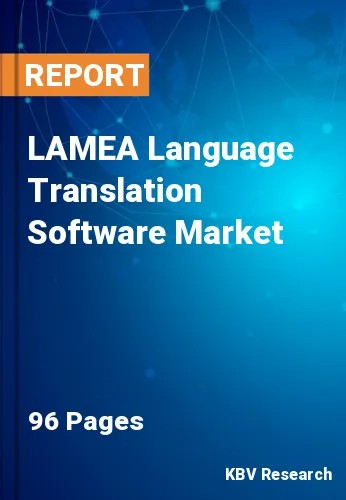The Latin America, Middle East and Africa Language Translation Software Market would witness market growth of 20.5% CAGR during the forecast period (2022-2028).
In recent years, improvements in natural language processing (NLP) and data accessibility have led to the development of more accurate and user-friendly translation software, which has increased its adoption among end users. For instance, the most recent development in Japan is a digital concierge platform that can translate 109 foreign languages for the hotel and tourism industries. Guests and hotel personnel can converse in real-time in their respective native tongues using the system, and the messages are automatically translated into the recipient's language.
This opens up new possibilities and innovation value, improving translation's role and expanding the translation software market. Consumers, customers, and other organizations like language translation software as a teaching tool for improving consistency and quality and for advancing ICT competencies. Additionally, the software is utilized to improve translation quality, effectiveness, and speed.
Mercosur is the fourth-largest trade group in the world. This group comprises Brazil, Venezuela, Bolivia, Argentina, Uruguay, and Paraguay. More than 260 million people inhabit the region as a whole. The Mercosur trade bloc uses Portuguese and Spanish as the two official languages. International trade contacts are successful owing to Mercosur's negotiating strength. The Mercosur nations have agreements for political and economic cooperation with many different nations across every continent. The Mercosur nations have agreements for political and economic cooperation with many different nations across every continent. In Latin America, Mercosur is attracting more international companies to have their bases in this region. In the coming years, all these factors are promoting the growth of the regional language translation software market.
The Brazil market dominated the LAMEA Language Translation Software Market by Country 2021, and would continue to be a dominant market till 2028; thereby, achieving a market value of $433 million by 2028. The Argentina market is experiencing a CAGR of 21.1% during (2022 - 2028). Additionally, The UAE market would showcase a CAGR of 20.2% during (2022 - 2028).
Based on Component, the market is segmented into Solution and Services. Based on Solution Type, the market is segmented into Rule-based Machine Translation, Statistical Machine Translation and Hybrid Machine Translation. Based on Vertical, the market is segmented into IT & Telecom, Manufacturing, Education, Healthcare, BFSI, Travel & Tourism and Others. Based on Enterprise Size, the market is segmented into Large Enterprises and SMEs. Based on countries, the market is segmented into Brazil, Argentina, UAE, Saudi Arabia, South Africa, Nigeria, and Rest of LAMEA.
Free Valuable Insights: The Global Language Translation Software Market is Predict to reach $26 Billion by 2028, at a CAGR of 17%
The market research report covers the analysis of key stake holders of the market. Key companies profiled in the report include IBM Corporation, Google LLC (Alphabet Inc.), Acolad Group, AppTek, LanguageLine Solutions (Teleperformance SE), inRiver AB, Babylon Software Ltd., Lingotek, Inc., and SYSTRAN S.A.
By Component
By Vertical
By Enterprise Size
By Country
Our team of dedicated experts can provide you with attractive expansion opportunities for your business.

